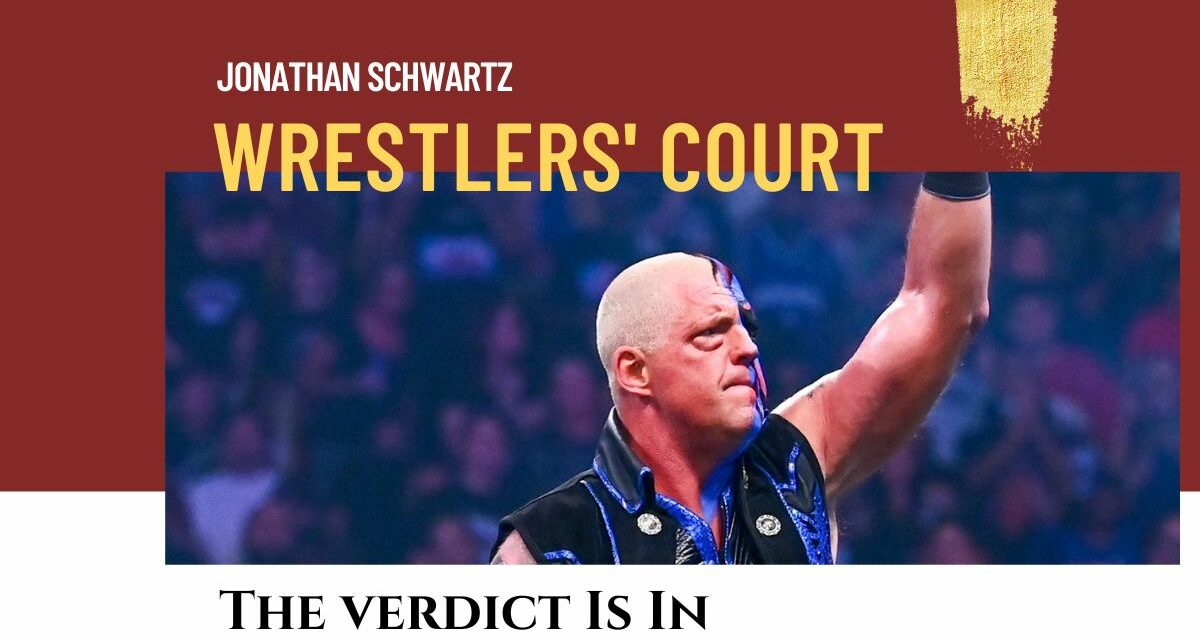Since returning to WWE in 2022, Cody Rhodes’ throughline has been his need to “finish the story” and win the WWF/E world heavyweight championship which he claims eluded his father, Dusty Rhodes. I think that a Cody WWE title run is inevitable and I welcome it. I think he’s developed into a great wrestler with a look and interview style that borrows from his father without copying him, and that he has learned the importance of elevating himself after getting bogged down in a ‘gatekeeper’ role in his later AEW run. Cody is 38 years old now; about the same as Roman Reigns. If WWE is going to put a world title on Rhodes one would hope they do so soon. I think he’s one of the few characters who could pull off a sustained babyface run as champion like Hogan or Backlund… or to put a nightmarish twist on the story he wants to finish as a long-reigning heel in his own right. I still think Cody is a better heel than a face, and since the early 1990s WWE has adopted more of a ‘chase’ mindset when booking its babyfaces.
But I don’t think that this is the story that most urgently needs completing. In fact, if you’re looking for a story to finish, I suggest that focusing on Cody at this point is travelling along the wrong Rhodes to the wrong destination. Instead, may I suggest that if you’re a real pro wrestling fan the story we should be rooting for is an improbable Dustin Rhodes world championship run, with the promotion (or it’s successor) where his father and brother have both held Ten Pounds of Gold.
That’s right. It’s 2023 and I’m writing a column about why in the face of his imminent retirement, Dustin Rhodes needs to win the NWA World’s Heavyweight wrestling championship.
I like the idea that Cody is animated by this need to right an historic wrong against his family-but it somehow feels reductive of his family’s and his own legacy — to say nothing of the legacies of other second or third-generation wrestlers.
By this point, there have been several superstars who’ve eclipsed the in-ring accomplishments of their parents. The Rock may be the most famous example, although Randy Orton and Bret Hart both spring to mind. All three men at times leveraged their famous family names, but none of them projected the idea that their own victories vindicated their lineages. Current champion Roman Reigns is himself a second-generation wrestler (maybe loosely third generation if you accept the broader Samoan wrestling bloodline, which begins with High Chief Peter Maivia). Reigns often name-checks his elders but makes it clear that his title wins are about him — and his heel actions are justified by his quasi-gangster character. Randy Savage and Bray Wyatt (R.I.P.) tick off the same boxes — Angelo Poffo, Blackjack Mulligan and Mike Rotunda were all successful wrestlers who never won the big one. Savage won six world titles between the WWF and WCW. Wyatt was a three-time world champion. Neither man’s lineage was openly acknowledged while they were performing.
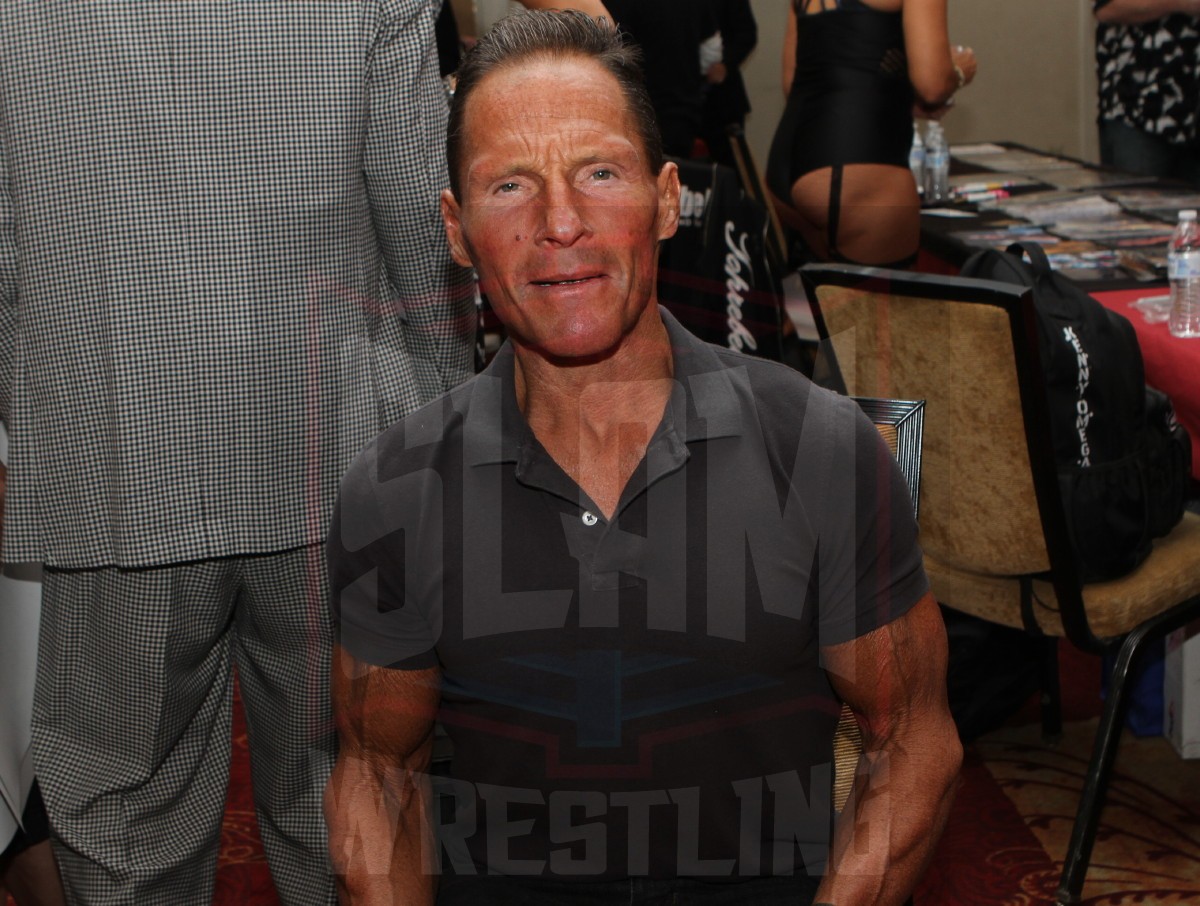
David Sammartino in 2019. Photo by George Tahinos, https://georgetahinos.smugmug.com
Likewise, there are many second-and-third generation wrestlers who never reached the championship heights of their fathers. Most, like Joe (Curtis Axel) Hennig or Greg Gagne understood that their roles just differed from their parents. Some, like Shawn Stasiak got how the business works but still longed for a more prominent role, seeing their fathers’ success as a legitimate standard in an illegitimate sport. A few, like David Sammartino, took these feelings further, into an unhealthy place of personal entitlement which ultimately cost him a career in pro wrestling and his relationship with his father. Then you’ve got wrestling progeny like David Flair, who might have had done more if WCW hadn’t seized on his family name and pushed him as a joke before he even learned how to lace up his boots correctly.
Cody’s argument that defeating Roman Reigns and winning the lineal WWE championship would ‘finish a story’ runs against one of the great things about professional wrestling: whether you see it as sport, art or soap opera, the story never ends. A title victory may be great, but as fans we think more about what happens after — how long a titlist holds a championship, which contenders they face, the quality of matches that come out of their reign, the storylines used to support those matches and the extent to which they build up the next champion in their defeat.
Dusty Rhodes was a huge star and in his own words at one point “the second most recognizable athlete in the world”, but his WWF runs were limited. The Dusty we know and love was born in 1974, when a then-heel Rhodes turned face following a tag team match with Pak Song in Eddie Graham’s Florida territory. Florida would become Rhodes’ home base — and it’s where he adopted his “American Dream” working class hero persona.
Dusty is synonymous with the NWA, having captured its World championship officially three times (plus one brief unrecognized run under a mask as the Midnight Rider, and likely a host of house show victories that would later be undone by his eponymous finish). The senior Rhodes’ title runs were brief by design. Jim Cornette has pointed out that Dusty was not what NWA leadership had in mind for its champion — he just didn’t look, sound or act the part. He was undeniably over with fans, and that forced the NWA’s hand. Promoters recognized that not giving him the belt at some point would kill his credibility and diminish his drawing power. The NWA championship as a touring gimmick and later, in Jim Crockett Promotions’ hands was mostly based on a neutral to heel champion. The money for local promoters (and eventually Crockett) lay in building up local challengers for fans to cheer against the ‘best wrestler alive’.
By contrast, the WW(W)F was a self-contained regional promotion — although one based in the biggest media market in the United States with penetration in significant markets across the Northeast. The WW(W)F’s relationship with the NWA would wax and wane. It was born out of Vince McMahon Sr.’s preferring “Nature Boy” Buddy Rogers as champion over the NWA’s eternal titlist, Lou Thesz. McMahon would crown Rogers as champion but quickly shift gears to Bruno Sammartino, ushering in a completely different approach to booking the promotion’s title. From 1963 until 1992 the WW(W)F world championship would be held for extended periods of time by a series of hard-working ethnic or All-American champions, fending off a rogues gallery of rotating challengers. The formula endured throughout the 1980s (when Dusty was arguably most popular in the NWA, although he was getting older and his in-ring performances started to decline), when the WWF’s national expansion meant the whole roster became a touring show.
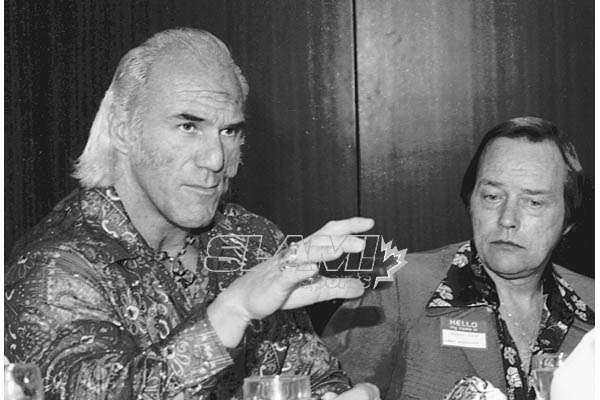
Superstar Billy Graham and Gordon Solie in 1975.
Pre-expansion, WW(W)F fans would reliably see ‘their’ world champion against a parade of invaders, who would work their way up the card to a series of title bouts, then disappear for the most part to another territory (or, as the business shrank with the WWF’s growth, more likely to JCP, the dying AWA or holdouts like Calgary, Dallas, Portland or Memphis). Dusty Rhodes’ decades as a main eventer clashed with the WW(W)F’s booking style. A usurper with a Texas drawl and culturally appropriated mannerisms wasn’t going to unseat an Italian or Puerto Rican hero in cities where those communities were vibrant; and he wasn’t going to overtake McMahon Sr.’s creation in Bob Backlund, who had been promised his run a year in advance. If that were the case, the by-then WWF already had its own version of Rhodes in champion “Superstar” Billy Graham. Graham’s promo style and constant playing to the crowd mirrored Rhodes’. Graham’s colorful persona, outfits and bodybuilder’s physique also looked more like a ‘champion’ — consistent with the NWA’s criticisms. Graham was a rare long-tenured heel WWF champion compared to transitional heel champs like Ivan Koloff or Stan Stasiak or the Iron Sheik, but it’s worth noting that by the standards of the day Graham might have seemed like a flash in the pan, measuring his reign in months instead of the years’ long runs of Sammartino, Pedro Morales, Backlund and Hulk Hogan.
Speaking of the latter there has long been conjecture that if Hulk Hogan had not defected from Verne Gagne’s AWA where he was already established in his “Hulkamania” persona, Rhodes would have been on the short list to carry the Rock ‘n’ Wrestling connection. I can see it in theory, but under Vincent K. McMahon, pro wrestling became about the body beautiful — and Hulk Hogan bore none of the regional tics, if you weeeeel, that defined Dusty’s character. I would have thought that wrestlers like Magnum TA, Tito Santana, Junkyard Dog (who was a world-beating talent for Bill Watts and became the early Number Two face of the WWF in the 1980s), Sgt Slaughter (before an attempt to unionize the locker room resulted in his being blackballed for years until his own transitional heel championship run) or Kerry von Erich would have better fit the bill.
Dusty Rhodes had two WWWF/WWF/WWE runs as an active competitor. The first, in more of his athletic prime, took place between 1977 and 1983. Rhodes would regularly barnstorm different promotions for shorter stretches. Between September and October, 1977 he main-evented Madison Square Garden twice against defending champion “Superstar” Billy Graham. In typical WWWF fashion, Rhodes won the first bout by count out, raising fans’ hopes that he would dethrone the hated Graham. He would lose the second — a brutal Texas Death match — when he and Graham knocked each other out and Graham fell on top of Rhodes for the pin. They would feud off and on in other territories for years. Photos of the two men bloodied, locked in combat sold thousands of kayfabe-era wrestling magazines.
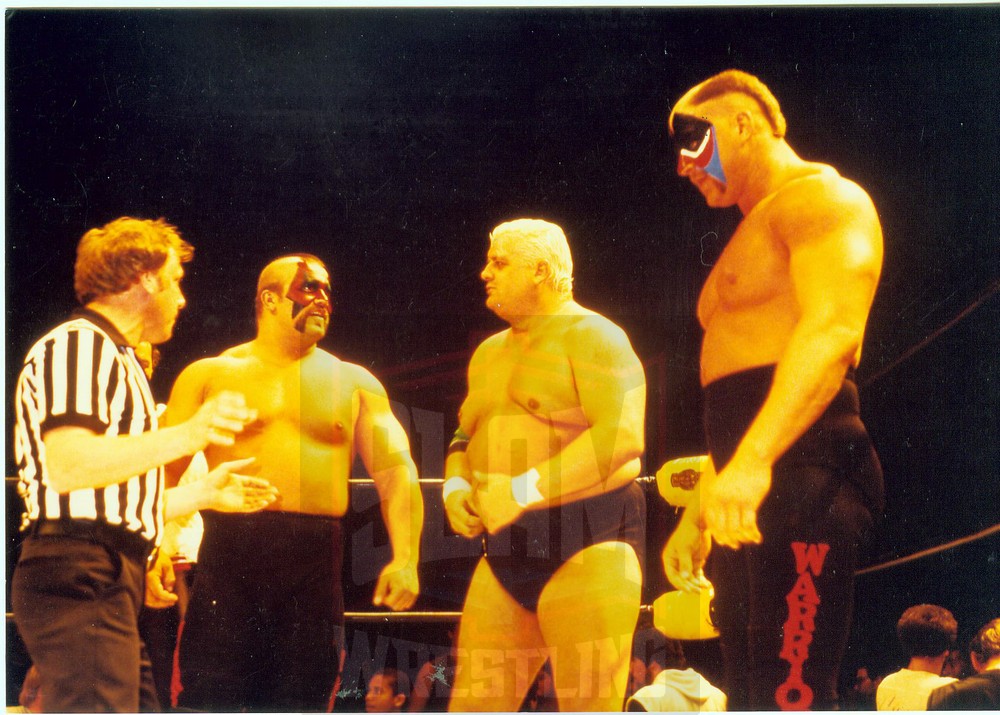
The Road Warriors with Dusty Rhodes. Photo by Mike Lano, wrealano@aol.com
Dusty’s second WWF run infamously began in 1989, after he had worn out his welcome as the NWA’s booker and gotten fired for intentionally bleeding in an angle with the Road Warriors. By this point Dusty was already in his mid-40s, and while wrestlers’ careers often have different shelf-lives than athletes’ in other sports, age, injuries and conditioning issues had taken their toll on Rhodes’ in-ring abilities. Instead, we got a gyrating, polka-dot wearing mid-carder. It has been said that Rhodes’ ‘Common Man’ character was meant to put him in place after his run with WWF archrival JCP. While that may be true, I think it’s as likely that it came out of a misapprehension of what made ‘Dusty Rhodes’ resonate with audiences. McMahon focused on the ‘Common Man’ aspect of the character, reintroducing him to WWF audiences through a series of vignettes that showed him performing what some might consider ‘menial’ jobs (I disagree; I deeply respect anyone who’d do a job that I could not, no matter what it is). What McMahon’s version of Dusty Rhodes lacked was the ‘rags’ to ‘riches’ part which was essential to Rhodes’ popularity elsewhere.
Dusty got over because Dusty put himself over — in the NWA that meant shoving his way into a main event scene where grizzled veterans like Harley Race or flashy arrivistes like Ric Flair would argue he didn’t belong. One can see how WWF feuds with ‘Million Dollar Man’ Ted DiBiase and Randy ‘Macho King’ Savage tried to recreate some of this, but while Rhodes would win most of these matches, his progression up the card was limited. Fans weren’t going to see Rhodes challenge Hogan or the Ultimate Warrior, and WWF wasn’t going to risk the equity built in those champions on the possibility of Rhodes turning them heel to frame an underdog win. Rhodes’ improbable comebacks against long odds and bloodbath victories eked out against foreign menaces helped build his character. Without an arc of world-beating victories and a push to a title, he just wasn’t Dusty. In late 1990 Rhodes would be offered the chance to return to WCW as it’s head booker. He quickly slid down the card, but his last significant WWF match occurred in 1991, where he fought alongside his son Dustin in a losing effort against Virgil and DiBiase.
All of which is to say that barring some catastrophic counterfactual event, there’s no scenario where Dusty Rhodes would have fit in as WWF champion.
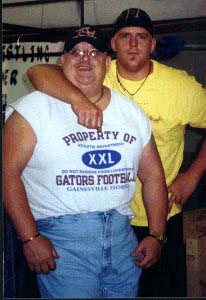
Dusty and Dustin Rhodes. Photo courtesy TurnBuckle Championship Wrestling
On December 3, 2022, Dustin Rhodes made the announcement that 2023 would be his final year as a competitor. Dustin noted that he’s had a long, 35-plus year career in pro wrestling and stated that he wanted to get out of the ring while he was still relatively healthy. He has told the story of being in a locker room early in his career and watching veteran wrestler Ray Candy (who died at 42 years old) struggling with a walker. Of course, Rhodes appeared to walk those comments back by April of this year, because retirements in wrestling aren’t what they used to be (I’ll get to Edge and his possible retirement another time) or maybe if you ask the likes of Roddy Piper, Rick Martel, Terry Funk or Ric Flair, wrestling retirements are the same as they’ve been since forever.
But let’s play out the string and assume that Dustin is nearing the end of his in-ring career. Dustin is 54 years old, 16 years older than Cody. He has hinted at his impending retirement repeatedly over the last few years and his Wikipedia page currently lists him as semi-retired. Dustin acknowledges that since joining AEW he’s done much more training new talent and working behind the scenes than he has as a performer. On the rare occasions where he gets into the ring, he’s mostly seen on Rampage in an attempt to build other stars. Lately he’s been teaming with the inexplicably lost Keith Lee. That said, when he does have the platform to wrestle a singles match he can still go.
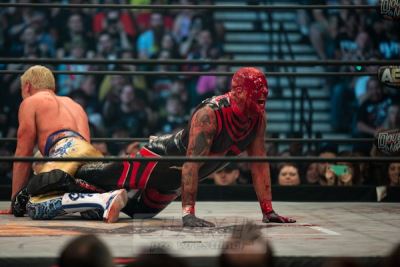
Dustin Rhodes is a blood mess against his brother Cody. Photo by Ricky Havlik, https://www.instagram.com/havlik_photo/
Dustin’s first AEW match tool place on May 25, 2019, at the Double or Nothing pay-per-view. Rhodes wrestled under his old “Natural” nickname and sported a variation of his Goldust look. He painted half his face, using red and black instead of shiny metallics, and wore a matching bodysuit. This match, more than any younger Rhodes title win was vindication for both Rhodes kids. It had minimal build but leveraged AEW ‘smart’ fans knowledge of how WWE had dropped the ball on the breakup of the Rhodes’ tag team and Cody’s burial in a sillier version of the Goldust gimmick. The match itself was stunning. Dustin was already over 50 years old, and he turned out a match that Dave Meltzer would rate five stars. More recently, in May 2022 Dustin had a match on Dynamite against CM Punk. It was a deliberately imperfect match, telling the story of two older wrestlers whose bodies couldn’t quite capture their former work rates, but whose hearts were up to the challenge. The match built from a slow pace to an exciting finish. It featured an extended sequence that functioned as a Bret Hart tribute and ended with a replay of the Hitman’s loss to the British Bulldog at SummerSlam 1992.
Dustin has had a few matches since then, notably losing to Sammy Guevara and Powerhouse Hobbs. He’s still a technically sound wrestler with a great punch (I see you, Bob Cook) who can bust out a flying move if the moment calls for it — and who is adept enough at reading an audience that he knows when the moment calls for it. He’s in phenomenal shape for any age, and after spending a good chunk of his life battling a significant substance abuse issue he says he has been sober for over 15 years. I hope he sticks with it, and I think that before he fully retires, Dustin deserves a run with a championship.
I don’t know Dustin personally but based on his social media presence and interviews he’s given over the years Dustin seems to have his father’s creative streak. He has figured out how to leverage even the strangest gimmicks into ongoing relevance. Rhodes’ evolution of Goldust’s look is instructive. Yes, he’s 54 years old and at times he’s lived a hard life. In street clothes and with his sleeves rolled up to show off his tattoos, he looks it (on the off chance he reads this, please don’t take that as a slight. We all have our scars, self-inflicted and otherwise). But between the facepaint and the full body costumes, Rhodes is able to camouflage his age and let his promos and his ring work talk for him.
One could argue that one reason Dusty never won the WWF championship was that he didn’t look the part. I think the same reasoning supports Cody being in the right place at the right time with the right look, whenever he does win a WWE world title. Dustin either didn’t need the belt with his bizarre persona, or he was too clearly struggling with conditioning and addiction or age to be seriously considered as champion. Recently, Dustin claimed in a now-deleted tweet that Hulk Hogan allegedly refused to work a WrestleMania match with him, with Hogan citing Dustin’s physique as a reason not to do business. If true, that’s a loss. Regardless of the size of his pythons, Dustin was an excellent heel and one of the last to successfully leverage a stereotypically ‘gay’ gimmick, although one that owed more to ‘Exotic’ Adrian Street’s flamboyant tough guy than ‘Adorable’ Adrian Adonis’ outright caricature. Rhodes understood the importance of selling for a babyface, and for all of his glam, could have gotten a much better match out of Hogan than the lame fan services matches that marked the end of his main WWF/E tenure and the diminished return comebacks that followed (except for his tilt against The Rock at WMX8).
I’m not one of those fans who thinks that a world championship reign is the measuring stick for a wrestler’s career. Given the predetermined, storyline-heavy world of pro wrestling that would just be silly. I’ve listened to enough Vince Russo podcasts to understand that a title belt is just a prop and reflects a promoter’s belief that the person who holds it will generate more money for the promotion. Not every wrestler will be in that position, and some do a good enough job of drawing fans with their charisma or gimmicks or in-ring performances that they ‘don’t need’ the belt. One could argue that Dustin’s ‘Goldust’ persona which he inhabited off an on with the WWF/E for 23 years would fall into that category. By turns controversial and hilarious, Dustin played that role across multiple scenarios, and in his last WWE turn from 2013-2019 unveiled an age defying physique and moveset which he has kept up since.
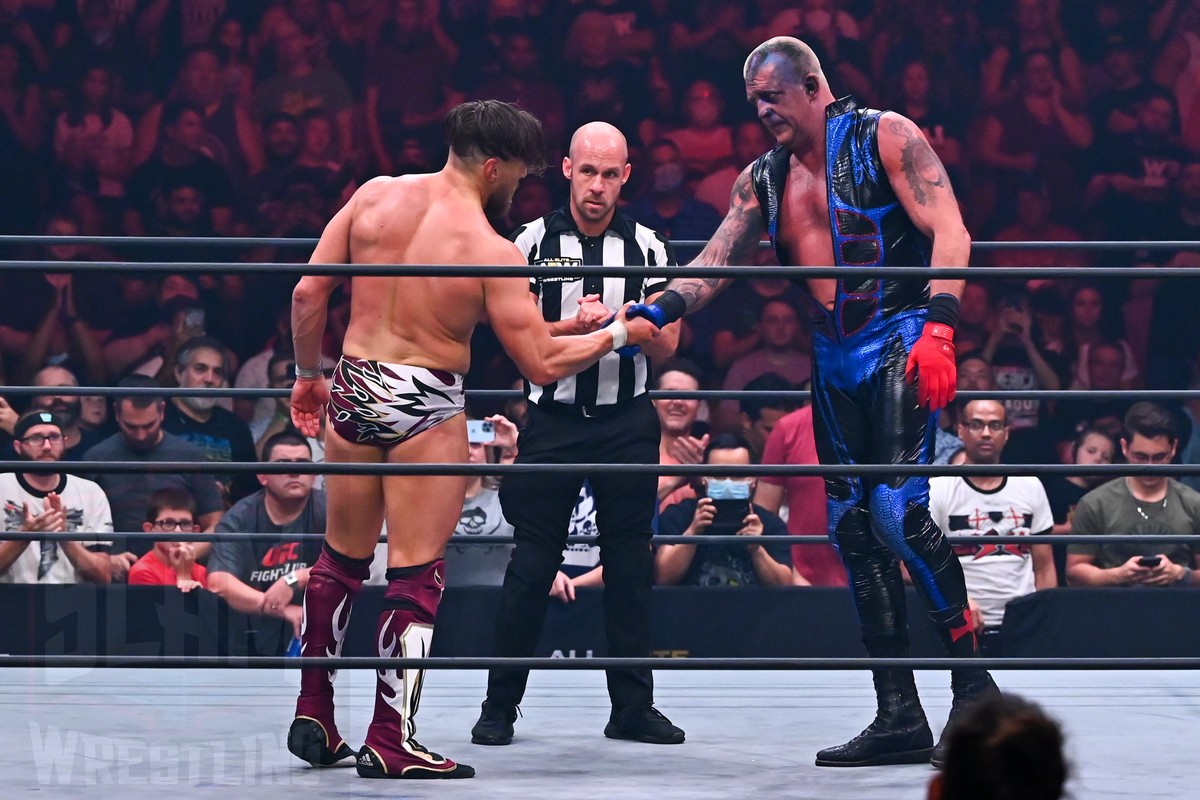
Bryan Danielson vs Dustin Rhodes at the Addition Arena in Orlando, FL on October 23, 2021. Photo by Joe Hrycych, www.hrycychphotography.com
All of which is why, before he retires, I want to see Dustin Rhodes win the NWA World championship. At this point, AEW seems to be committed to a combination of newish NJPW and WWE alumni titlists as they build their brand. Even more recently, they’ve started leaning in the direction of more homegrown talent like MJF as champion. Dustin’s role backstage has been emphasized, as it was in a recent Twitter argument with independent women’s wrestler LuFisto. In AEW Rhodes seems to be among the backstage staff charged with building AEW’s women’s division.
Hopefully, that leaves his dance card empty enough to set up an NWA title victory and at least a short reign.
At this stage of Dustin’s career, an NWA run feels like it would work. It’s also within the realm of the possible. Current NWA owner Billy Corgan has repeatedly mentioned that he is open to working with AEW and other promotions, and that the relationship between AEW and the NWA remains good, even after AEW poached Thunder Rosa. AEW had sent female talent to bolster the NWA’s all-women Empowerrr card in 2021, and while there was a dispute over how that talent would be paid, Corgan at least insists that the relationship between the two promotions remains ‘fine’.
AEW regularly partners with other promotions, most notably Japan’s NJPW and Mexico’s AAA. Not that long ago AEW also featured rival Impact Wrestling in a main event angle which saw Kenny Omega beat Impact’s Rich Swann for its world title, only to drop it to fellow AEW star Christian Cage. I think that angle ran out of steam prematurely because of Don Callis’ exit from his backstage role with Impact and the usual challenges of coordinating long-term storylines between companies with their own agendas.
Loaning Dustin Rhodes to the promotion that made his family famous wouldn’t require exceptionally long-term booking, nor would it mean risking one of AEW’s biggest stars’ reputations in a hostile territory. AEW is bigger than the NWA at this point, but from a wrestling nerd perspective it also doesn’t have the weight of history behind it that WWE does. One could argue that for pro wrestling purists the NWA is the gold standard.
The Rhodes name would mean more to the NWA than it does to AEW. Most importantly, it gives Dustin the opportunity to really ‘finish the story’ of the Rhodes’ legacy. I’ve already covered Dusty, but Cody (without his surname due to a trademark dispute with WWE at the time) won the NWA World’s championship, swapping it with Nick Aldis and claiming a 50 day reign. Cody also beat Christopher Daniels for the ROH championship in 2017, enjoying a 175 day reign before dropping the belt to Dalton Castle. While Cody’s NWA reign took place during a low ebb for the organization, he brought new eyes to Billy Corgan’s attempt to recast it as a standalone promotion-ironically at the first pre-AEW ‘All In’ pay per view.
So far as I know, the only siblings to hold the same world championship are the Bella Twins, Dory and Terry Funk with the NWA and Matt and Jeff Hardy with TNA/Impact-although one could argue whether the latter was a ‘world’ championship when both Hardys held it. I can think of fewer cases where a father and son have held the same world championship. One could argue Ric and Charlotte Flair count due to gender inequities, but I think that’s a stretch. There are plenty of wrestling families where one brother has held a world title: the Harts, Poffos, Briscoes, Briscos, Von Erichs and a few Anoa’I branches spring to mind (Yokozuna and Roman Reigns are both part of the same extended family, but each had their own sibline). In some cases, the title could become the focus of a feud between brothers. That’s unlikely here, but if WWE Head of Creative Paul ‘Triple H’ Levesque is more open to acknowledging the world outside WWE, he could help foster a meaningful moment for fans just by allowing Cody to be seen celebrating a Dustin Rhodes win. It might make up for Triple H’s recent slight against AEW, calling it a “secondary promotion”.
I suppose that Dustin could accomplish something similar with an ROH title victory — it would complete the set with Cody, but as Tony Khan struggles to figure out what to do with his second promotion I would argue that Dustin beating Claudio Castagnoli for the ROH title wouldn’t make sense. That title needs a workhorse champion, and as good as Dustin can still be, I don’t think he could keep up the required pace and the title would suffer from lack of visibility and a transitional champion.
Corgan has been open about his ambition to “figure out that formula where you can take really good mainstream professional wrestling, and bring it to the people and once again, sort of bring back those greater numbers.” He sees the NWA as a viable promotion, perhaps one that can eventually challenge the WWE’s dominance based on leveraging Corgan’s own media connections after decades in the music industry (although Rick Rubin’s dalliance with Jim Cornette’s Smokey Mountain Wrestling might offer a cautionary tale) and putting out “a mainstream wrestling product that the average person if presented on television will respond to”. Corgan acknowledges that this is a tall order, and one that he will struggle to meet given his recent penchant for casting performers with lesser WWE runs as his main eventers.
Until recently I would have suggested the NWA was on a better track. Cody, along with Nick Aldis and Matt Cardona, offered a somewhat younger more athletic, charismatic champion. But Corgan has had trouble maintaining these contracts and has retreated to booking older talent who’ve been out of the spotlight longer with champions like Trevor Murdoch or Tyrus. Nothing against either of these men, but they give every appearance of being physical throwbacks in a sport that has become ever more athletically demanding. As it stands, Dusty Rhodes of yore would have fit in at the top of the card.
Dustin Rhodes isn’t much older than Murdoch or Tyrus, but he’s in much better shape and has always projected more star quality. He also affirms the NWA’s legacy and could credibly transfer the title and its prestige to a much younger, more athletic standard bearer. Dustin Rhodes understands his place in professional wrestling. Crowning him as NWA champion would just give him his rightful place in wrestling history.
TOP PHOTO: Dustin Rhodes on October 23, 2021. Photo by Joe Hrycych, www.hrycychphotography.com
RELATED LINKS
